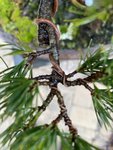Boon tells stories of his apprenticeship days... He wasn’t given any instruction, or at least not much. He was expected to learn by doing. If he messed up, he heard about it!You just described the Japanese biz model. Except there they don’t teach the customers unless they want to be involved at the high end level. There are newbs butchering rough stock in Japan too. There are also lots of shitty trees there. They just don’t show them to anyone on the Intl level.
The clients basically treat the truly great bonsai as living art pieces, but they are passed on like fine art. Auctions, appraisals, dealers, agents, translators, etc. The market ebbs and flows. Kimura’s work is big this year. Now Ebihara’s maples are released from a major private collection.... It just like Southerby’s, but broken down by quality tiers. There are local lower quality bonsai tree and bonsai pot auctions all over Japan.
But, to learn wiring, he went out into the garden and looked at the trees there. And figured out how it was done.
I do the same. Even though I’ve been taught by Boon, I’m still open to learning. I recently had Tyler Sherrard style one of my trees. And I’ve closely examined his work. And while I’m pretty good at wiring, he’s at a whole ‘nuther level!
Look at this:

Anyone see anything remarkable about that?
He’s managed to anchor the thin wire to the heavier wire so that it acts as a single unit. Would I have Come up with that? I don’t think so! But, I’ll add that technique to my bag of tricks!
It’s things like that you can learn from closely observing the work of a pro. You’ll never see anything like that in a book or video.




